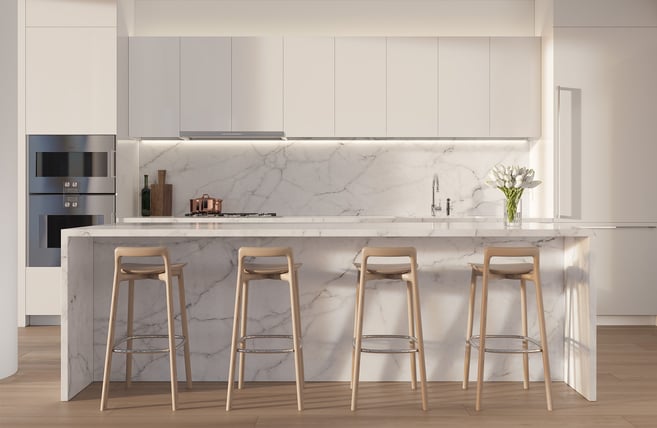
Essential Marble Countertop Maintenance Tips: How to Keep your Marble Surfaces Looking Beautiful

Marble countertops are an elegant and timeless addition to any home, adding a touch of luxury and sophistication to your kitchen or bathroom. However, as beautiful as they may be, marble surfaces still require careful maintenance to ensure they maintain their natural shine and durability over time.
Below are some essential marble countertop maintenance tips to help you keep your marble surfaces looking beautiful:
Seal Your Marble Surfaces
To prevent stains and damage, it’s important to seal your marble countertops every 6 to 12 months. This will help to protect the surface from spills and scratches; and keep it looking its best for longer. There are many marble sealers available on the market, so make sure to choose one that is specifically designed for use on marble surfaces.
Topical Sealers are coatings (film formers) designed to protect the surface of the stone against water, oil, and other contaminants. They are formulated from natural wax, acrylic, and other plastic compounds. When a topical sealer is applied, the maintenance program often shifts from a program focused on stone care to a program focused on the maintenance of the sealer.
Impregnators are water or solvent-based solutions that penetrate below the surface and become repellents. They are generally hydrophobic (water-repelling), but are also oliophobic (oil-repelling). Impregnators keep contaminants out, but do not stop the interior moisture from escaping. These products are considered “breathable,” meaning they have vapor transmission.
Before sealing, always read the manufacturer’s warranty and instructions.
Perform Normal Cleaning on Countertop Surfaces
Normal maintenance involves periodic washing with clean, potable water and neutral (pH 7) cleaners. Soapless cleaners are preferred because they minimize streaks and film. Mild, phosphate-free, biodegradable liquid dishwashing soaps or powders or stone soaps are acceptable if rinsing is thorough.
Wet the stone surface with clean water. Using the cleaning solution (following manufacturer’s directions), wash in small, overlapping sweeps. Work from the bottom up if it is a vertical surface. Rinse thoroughly with clean, potable water to remove all traces of soap or cleaner solution. Change the water in the rinse pail frequently. Dry with soft cloth and allow.
Clean stone surfaces with a few drops of neutral cleaner, stone soap (available at hardware stores or from your stone dealer), or a mild liquid dishwashing detergent and warm water. Use a clean, soft cloth for best results. Too much cleaner or soap may leave a film and cause streaks. Do not use products that contain lemon, vinegar, or other acids on marble or limestone. Rinse the surface thoroughly after washing with the soap solution and dry with a soft cloth. Do not use scouring powders or creams; these products contain abrasives that may scratch the surface.
Clean Spills Quickly
Marble is a more porous stone, which means that it has the potential to absorb liquids and stains more than other surfaces. To prevent this from happening, it’s important to clean up any spills quickly. Use a soft, clean cloth and a mild, pH-neutral cleaner to wipe up spills, and avoid using acidic or abrasive cleaners that can damage the surface of the marble.
Avoid Cutting Directly on the Marble Surface
Cutting directly on the marble countertops can leave scratches and damage the surface. To prevent this, always use a cutting board when preparing food on your marble countertops.
Keep Acidic Substances Away from your Marble Surfaces
Acids, such as lemon juice and vinegar, can etch the surface of marble, leaving it dull and damaged. To prevent this from happening, avoid using acidic substances on your marble countertops.
Use a Soft, Non-Abrasive Cloth for Cleaning
When cleaning your marble countertops, it’s important to use a soft, non-abrasive cloth to prevent scratching the surface. Avoid using steel wool, scrub brushes, or other abrasive cleaners that can damage the surface of the marble.
Use Coasters and Trivets
To prevent scratches and stains, it’s important to use coasters and trivets on your marble countertops. This will protect the surface from hot dishes, spills, and other potential sources of damage.
In conclusion, taking care of your marble countertops doesn’t have to be complicated. By following these essential maintenance tips, you can ensure that your marble surfaces stay looking beautiful for years to come. With a little care and attention, your marble countertops will continue to be a stunning and timeless addition to your home.


